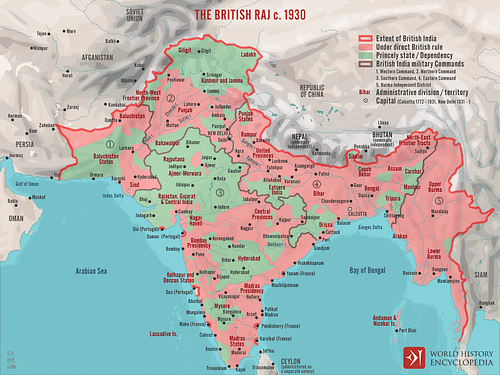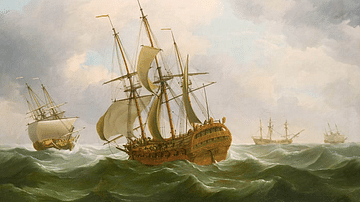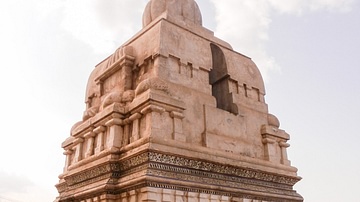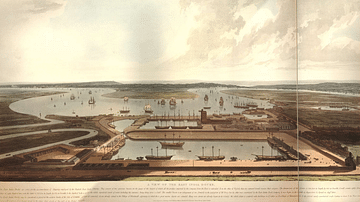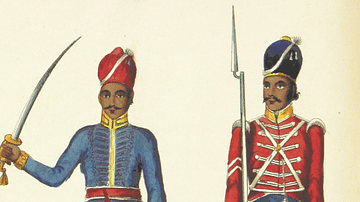
The Indian Princely States (aka Native States or Princely India) were those states in the Indian subcontinent the British did not conquer but which were typically bound by treaty first to the East India Company and then to the British Crown. Many Indian princes consequently received 'protected' status, but this involved regular payments of tribute and/or concessions of territory.
The princely states varied greatly in size and at one time numbered up to 700 depending on the classification used. At first enjoying lucrative arrangements with Portuguese, French, and British traders (amongst others), many independent Indian rulers came to hold an ambiguous relationship with the ultimately dominant British East India Company (EIC). The EIC, and its successor from 1858, the British Crown, extracted wealth in return for military assistance and imposed its inspectors and foreign policy on native rulers. Many princes were left to rule as they always had done so that interference in internal affairs was often minimal. The princely states were merged into independent India or Pakistan after 1947, and their rulers were eventually pensioned off.
A Myriad of Principalities
The Mughal Empire had controlled much of India for centuries, but it went into decline in the 18th century. The power vacuum left by the Mughals in various parts of India was filled by the British East India Company (EIC) – an armed trading company – or rising powers like the Marathas in central India and the Sikhs in northern India. Amongst these larger powers were several hundred princely states, which ranged in size from a large farm to an area covering the size of Britain.
The precise number of princely states in any given period varies depending on the criteria administrators and historians have used to classify them. A broad range is from around 550 to around 700, depending on the period. In all, the princely states came to be inhabited by some 180 million people in 1857 (compared to 123 million in British-controlled India). The British were keen to call these rulers 'princes', not 'kings', and their territories 'princely states', not 'kingdoms', as a constant reminder that the British monarch was supreme. To further distinguish the latter, from 1877, the reigning British monarch was called the Emperor or Empress of India.
Some hereditary rulers in the princely states traced their lineage so far back that there were no written records, only myths regarding their origins. Other ruling dynasties had established themselves in the Middle Ages, still others were more recent and had acted as vassals of the Mughal Empire. Most rulers were autocratic (although very often revered by their people). The majority were male, but there were some women governing these states, for example, Bhopal in north-central India had three female rulers (Begums) between 1844 and 1926, Manipur in the extreme northeast of India had occasional queens, and the ruling family of Cochin on the southwest coast inherited power through the matrilineal line.
Several smaller states might be grouped under the overlordship of a raja (Sanskrit for "king," "chief," or "ruler"). Several confederacies might join and be nominally ruled by a maharaja (a "great king"). Typically ruling their state using a structure of feudalism, rulers could be immensely wealthy from the natural resources in their state (anything from salt to diamonds), trade, and tribute from less powerful states. Several, like Cochin, had a long history of international contact, as reflected by their architecture such as Jewish synagogues, Christian churches, mosques, temples, and private mansions of English, Dutch, French, and Portuguese traders. Most states, though, remained insular and highly traditional in their political outlook and social and religious customs.
The most important Indian princely states included:
- Bahawalpur
- Baroda
- Bastar
- Bhopal
- Bikaner
- Cochin
- Cutch
- Gujarat
- Gwalior
- Hyderabad
- Indore
- Jaipur
- Jaisalmer
- Jammu & Kashmir
- Jodhpur
- Kalat
- Kengtung
- Kharan
- Las Bela
- Manipur
- Mysore
- Oudh
- Patiala
- Rewah
- Sikkim
- Travancore
- Udaipur
In modern usage, as many of the above names continue to be used today for cities and regions, they are often followed by the word 'state' or preceded by 'kingdom of' to denote a reference to the now defunct princely state, for example, 'Jaipur State' or 'Kingdom of Mysore'. Collectively, the states are sometimes called 'Princely India'. Additionally, not all the states were located in the area covered by today's modern state of India, some were located in what is today Pakistan, Bangladesh, and Myanmar, countries all formed after the British removed themselves from India in 1947.
The Expansion of the East India Company
From the mid-18th century, the EIC steadily took more and more control of the subcontinent, but it faced competition from other European trading companies. Sometimes Indian states would join forces with Britain's enemies. An example is Haidar Ali of Mysore who fought alongside the French and the Marathas to try and increase his control of southern India at the expense of the EIC. Ali's policies were continued by his son Tipu Sultan (1750-1799). Sometimes, as with Mysore's aggressive expansion, these wars brought the British new allies eager to defend their own boundaries, in this case, Travancore.
The final years of the 18th century saw a new policy direction for the EIC: 'Subsidiary Alliances' where princely states were persuaded or cajoled into accepting British protection, typically in the form of out-and-out conquest, battles, or sieges, or through the imposition of EIC garrisons paid for by the state either directly or in exchange for territory. While many states would have preferred the old status quo, some princes were enthusiastic to become protectorates since EIC troops helped them maintain their own positions of privilege and guard against invasion and internal rebellion. The first protectorate under this system was Hyderabad in 1798. The Nizam of Hyderabad requested EIC troops in return for an annual fee. Mysore signed a treaty with the EIC in 1799. The Governor-General Lord Wellesley (in office 1798-1805) went on to sign around 100 treaties over the next seven years. Ever keen for greater wealth, more treaties and more EIC expansion followed under Wellesley's successors, notably in the region around Bombay (Mumbai) in the west and in northeast India and in what is today Nepal (1816) and Burma (1826).
Into the 19th century, the British initiated a system of diplomacy with the princely states known as paramountcy. A rather vague term, the policy involved the EIC claiming itself to be the guardian of the peace and having the right to intercede in cases of disputed succession. Typically, a princely state had a permanent British Resident who represented the EIC, and some states also had an EIC garrison within their borders, as noted above. This diplomacy, though, was backed by guns and the ever-present threat of EIC military intervention. On occasion, the British intervened to depose a ruler, as happened with Bharmalji, the ruler of Cutch (aka Kachchh) in 1819; the reason given was that he had repeatedly attacked neighbouring states. Bharmalji was replaced by his son, then still a minor. Such direct intervention was rare since the British needed the princes as allies in their wars in other parts of India. Further, many rulers remained extremely popular with their subjects, and so any regime change threatened regional stability.
The EIC was an utterly ruthless organization, and it sought to acquire territory and riches by any means, fair or foul. One particularly unpopular policy of acquisition was the 'Doctrine of Lapse'. This policy, although not new, was imposed with far more enthusiasm by the Marquess of Dalhousie (1812-1860), EIC Governor-General from 1848 to 1856. If a ruler had no surviving son, he could not nominate another relative or person as his heir and so the EIC took over the state. Princely states acquired in this manner included Satara (1848), Baghat, Jaitpur, and Sambalpur (1850), Udaipur (1852), Jhansi (1853), Nagpur (1854), and Karauli (1855). Even accusations of poor governance led to some princes losing their throne, as happened with the Nawab of Awadh, or a slice of their territory, as happened to the Nizam of Hyderabad. The Governor-General went after certain nominal rulers, too, eliminating the titles of the Nawab of Carnatic, the Maratha of Peshwa, and the Raja of Tanjore. He also oversaw the second Anglo-Sikh War (1848), which annexed the Punjab, and the Second Burmese War (1852), which grabbed lower Burma for the EIC. Despite the Governor-General's attempts at what he called 'rationalizing' the map of India, there still remained a bewildering complexity of isolated states and dependencies across the subcontinent. The immediate consequence of Dalhousie's hyperaggressive policies was a great fear amongst the princes of what the EIC might do next. This fear meant their loyalty to the British system of rule was endangered.
The British Raj & the Princes
The EIC met its greatest challenge in 1857 when Indian soldiers in its own armies rebelled against their British officers. The Sepoy Mutiny then spread to become a wider rebellion against British rule, which now involved several princely states. One notable ruler who took up arms against the British was Queen Rani Lakshmi Bai of Jhansi (1835-1858). Some princely states supported the British, others tried, if they could, to remain neutral. The uprising was only quashed when 40,000 British soldiers were shipped in from Europe. The Mutiny was the final straw for the patience of the British government over the sordid affairs of the EIC. The EIC territories in India were taken over by the British Crown in 1858, the beginning of what became popularly known as the British Raj (rule) in India. Queen Victoria (r. 1837-1901) was declared the Empress of India in 1877. The empress promised in a speech to the Indian princes that
We shall respect the rights, dignity and honour of native princes as our own and we desire that they…should enjoy that prosperity and that social advancement…secured by internal peace and good government.
(Dalziel, 78)
The Doctrine of Lapse was abandoned, and princes were once again permitted to choose their own heirs, adopted or otherwise. Despite the British expansion, the independent Indian princely states still made up around two-fifths of Indian territory. As protectorates or enforced allies, most were allowed to conduct their own internal affairs independently, but their foreign policy was decided by the British. As the Viceroy Lord Curzon once stated, official British policy was to regard princes "not as relics, but as rulers, not as puppets, but as living factors in the administration" (James, 333).
A strict hierarchy of states was scrupulously maintained, as exemplified by the number of guns fired in official salutes, an honour greatly appreciated by rulers who themselves set great store in protocol and hierarchy. A state like Gwalior received the full 21-gun salute while others received 17, 11, or none at all. There were some material benefits to closer ties with Britain such as the construction of railways and the spread of telegraph wires. Princes were strongly encouraged to improve the infrastructures of their states such as sanitation, roads, schools, and hospitals. The results of this encouragement were patchy. Baroda in northwest India was a notable example of an Indian princely state with a much higher than average level of education, administration, and network of trains. Even if institutional and private racism were rife in the British Raj, there were attempts at what we today would call 'soft power'. Cricket was used as a means to bring East and West a little closer and was so widely adopted it ultimately became the national sport. In the other direction, the princely states offered the British elite an exotic world of jewels, galas, tiger-hunting expeditions, and polo matches.
The British tried to Anglicise the princes, continuing to impose a permanent Resident and encouraging their education or that of their children through the use of British tutors or even periods of study in England. Special colleges were established around India so that future rulers and administrators would be better integrated into the British Raj. Prominent princes like the maharajas were encouraged to visit Britain where they "were lionised by high society in London and on the continent. Regardless of their local means and status, they were universally regarded as exotic, powerful, and fabulously rich, fancies which they did nothing to dispel" (James, 324).

Aside from the more obvious colonial presence of soldiers and revenue collectors, the British displayed their power in more subtle ways, too, such as the use of British India postage stamps showing British monarchs but overprinted with the princely state's name. There was another, even more public display of the British sway over the princes. The rulers of the princely states paid public homage to the British Crown at events like the durbar, which involved military processions and extravagant elements of show such as parading elephants. The 1877 durbar to honour Queen Victoria becoming Empress of India was attended by over 400 princes.
The 1903 Delhi durbar saw princes pay homage to the new king Edward VII (r. 1901-1910) represented by the Viceroy Lord Curzon. The 1911 durbar was even more spectacular since King George V (r. 1910-1936) attended in person. Both of these durbars were filmed, and the reels were later shown in cinemas back in Britain, convincing the public that the British Raj was a rule through consent and mutual esteem. This was not true, of course, but neither were all the princes fiercely anti-British. The Raj was, for many, a means to perpetuate their own autocratic rule.
India's Independence
Several princely states contributed troops to the war effort during Britain's involvement in the First World War (1914-18). With the increasing success of anti-British political parties like the Indian National Congress and All Muslim League, a few rulers were enticed to also become more politically active, but there was little collaboration between the princes and the 'home rule' movement. The Indian National Congress, although being anti-monarchy (British and Indian), did try and encourage (but not directly intervene in) some princely states to adopt more democratic structures, but these efforts met with little success. The recognised leader of the free India movement was Mahatma Gandhi (1869-1948), and he was dismissive of the princes as nothing more than pawns nurtured by the British for their own ruthless game of empire. Indeed, some princes, like the Maharaja of Kashmir and Maharaja of Gwalior, forbade National Congress meetings in their territory.
In response to the changing times, the British formed the Chamber of Princes in 1921. The Chamber was composed of 120 princes and, presided over by the viceroy. it was designed only as an advisory and consulting body, but, nevertheless, an important bridge of contact was established between the princes and the British Raj. Unfortunately, little use was made of this bridge due to mutual suspicions, significant absences such as Hyderabad and Mysore, and a lack of clear purpose from the British on what exactly to do with these states in the face of growing calls for India's independence. Many of the princely states again helped the British during World War II (1939-45), contributing troops and money for gunboats, planes, and ambulances.
Many princely states retained some sort of independence until the end of the British Raj and full Indian independence in 1947, a negotiated process that the princes were not directly involved in. The 584 remaining princely states signed an agreement on 15 August 1947 to come under the supervision of the new Indian government in New Delhi. Although some large states like Hyderabad had considered going fully independent, in the end, and either peacefully or by invasion (actual or the threat of), all the states were absorbed into the new political reality which followed the immediate partition of the subcontinent into India and Pakistan. Some princely states, notably in Kashmir, remained disputed territory between India and Pakistan. In the 1950s, princes were effectively retired and given generous state pensions, a situation that continued until the early 1970s. The princely states might have disappeared, but one of their great legacies is the magnificent royal palaces dotted around the subcontinent, testimony to the power and wealth their owners once enjoyed.
